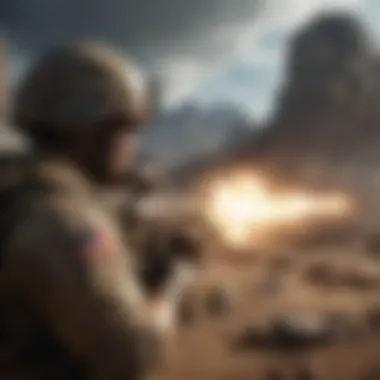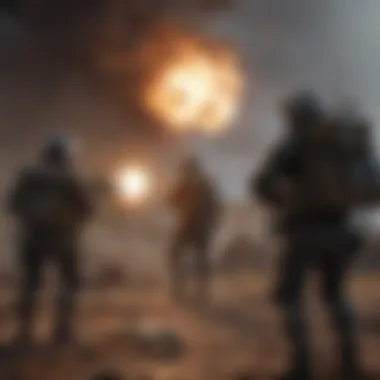Elevate Your Gameplay with Top War Game Strategy Guide


Game Reviews
In the realm of top war games, understanding the intricate dynamics is crucial. Embarking on a journey to unravel the essence of these games requires a keen eye for detail, a strategic mindset, and a thirst for victory. Let's delve into the core elements that define these virtual battlefields, from the troops at your command to the structures that fortify your position.
Overview of the Game
As you step into the virtual realm of top war games, you are greeted by a landscape rife with challenges and opportunities. Each game presents a unique setting, whether it be a futuristic dystopia or a historical battleground, offering players a chance to immerse themselves in a rich tapestry of lore and strategy.
Gameplay Mechanics and Features
Navigating the complex web of gameplay mechanics is where true mastery is forged. From resource management to unit deployment, every decision influences the outcome of your battles. Understanding the strengths and weaknesses of each unit, the efficiency of your resource gathering, and the strategic placement of structures are pivotal to securing victory on the digital battlefield.
Graphics and Sound Quality
Immerse yourself in stunning visuals and captivating soundscapes that breathe life into the war-torn worlds you inhabit. The crisp graphics and dynamic sound effects heighten the intensity of each encounter, drawing you deeper into the heart of the conflict.
Pros and Cons Analysis
Before diving headfirst into the fray, it's essential to weigh the pros and cons of each game. Evaluating aspects such as gameplay complexity, community engagement, and support for updates can help you tailor your gaming experience to suit your preferences and playstyle.
Tips and Strategies
Armed with a solid understanding of the game's foundations, let's explore the strategies and tips that will set you apart on the battlefield.
Beginner's Tips for New Players
For novice players taking their first steps into the world of top war games, establishing a strong foundation is key. Start by familiarizing yourself with basic gameplay mechanics, understanding unit roles, and honing your resource management skills.
Advanced Strategies for Experienced Gamers
Seasoned veterans seeking to elevate their gameplay to new heights can delve into advanced strategies that push the boundaries of conventional tactics. Experiment with unconventional unit compositions, practice precision timing in your attacks, and master the art of feinting to keep your opponents guessing.
Hidden Secrets and Easter Eggs
Exploring the nooks and crannies of these virtual worlds can yield hidden gems and unexpected surprises. Unraveling the mysteries tucked away in obscure corners not only adds a sense of discovery to your gameplay but also unveils valuable insights that could turn the tide of battle in your favor.
Updates and Patches Overview
Staying abreast of the latest updates and patches is essential to maintaining a competitive edge. Whether it's balancing changes, new content additions, or bug fixes, being vigilant about upcoming updates can help you adapt your strategies and stay ahead of the curve.
Device Reviews
While top war games offer the adrenaline-pumping thrill of strategic warfare, having the right device to support your gaming endeavors can enhance your overall experience.
Specifications and Features of the Device
Before making a device purchase, considering factors such as processing power, RAM capacity, and graphics capabilities is vital to ensure smooth gameplay and optimal performance.
Performance and Battery Life Assessment
Assessing the performance metrics and battery longevity of a device can determine its suitability for marathon gaming sessions. Look for devices that strike a balance between power efficiency and performance longevity to enjoy uninterrupted gameplay.
Comparisons with Similar Devices


Comparing the specifications and features of different devices can help you pinpoint the ideal gaming companion that aligns with your budget and performance expectations. Analyzing factors like display quality, ergonomics, and thermal management can guide you towards making an informed decision.
Value for Money Analysis
Investing in a gaming device is a significant decision, requiring a thorough evaluation of the value it offers. Consider the longevity of the device, its adaptability to upcoming gaming trends, and the overall return on investment to make a sound purchasing choice.
How-to Guides
Guiding you through the intricacies of top war games, these step-by-step tutorials, troubleshooting tips, and community engagement strategies aim to enrich your gaming experience and foster a sense of camaraderie among players.
Step-by-Step Tutorials for Game Objectives
Unravel the complexities of game objectives with detailed tutorials that break down missions, quests, and challenges into manageable steps. From mastering base building to executing decisive maneuvers, these guides provide a roadmap to success.
Troubleshooting Common Issues/Errors
Encountering technical glitches or performance issues can hinder your gaming experience. Equip yourself with troubleshooting techniques to diagnose and resolve common errors swiftly, ensuring seamless gameplay.
Optimization Tips for Smoother Gameplay
Fine-tuning your gaming setup can unleash the full potential of your device, optimizing performance and enhancing visual fidelity. Explore tips for configuring graphics settings, enhancing network connectivity, and streamlining gameplay for a polished experience.
Community Engagement Strategies
Fostering connections within the gaming community cultivates a supportive network of allies, mentors, and friends. Discover effective strategies for engaging with fellow players, joining clans or guilds, and participating in collaborative events to nurture a thriving gaming community.
Understanding War Game Strategy
Importance of Strategy in War Games
Strategic Thinking in Gaming
In the realm of war games, strategic thinking holds paramount importance. It involves the ability to anticipate, plan, and outmaneuver opponents through calculated moves. The hallmark of strategic thinking lies in its capacity to foresee outcomes and adapt to evolving dynamics swiftly. With each decision influencing the course of the game, strategic thinking serves as the cornerstone of successful gameplay. While advantageous for enhancing gameplay depth, strategic thinking demands a keen intellect and a knack for outsmarting adversaries. Its prowess in shaping battles makes it a strategic powerhouse in the arsenal of any player aiming for dominance.
Role of Planning and Execution
Planning and execution form the bedrock of successful war game strategies. The meticulous planning of every move, combined with precise execution, ensures maximum impact on the battlefield. Effective planning entails foresight, analytical thinking, and risk assessment to mitigate potential pitfalls. The execution phase demands agility, quick decision-making, and adaptability to capitalize on strategic opportunities. Despite its benefits in streamlining gameplay and achieving tactical advantages, planning and execution require players to maintain focus amidst chaotic virtual warfare. Their blend harmonizes the strategic landscape and separates successful from lackluster performances.
Elements of Effective Strategy
Resource Management
Resource management shapes the foundation of efficient war game strategies. It encompasses the allocation and utilization of resources, including troops, materials, and finances, to sustain and advance military endeavors. The key characteristic of resource management lies in its capacity to optimize limited resources for maximum impact. Adept resource management enables players to maintain a formidable presence on the battlefield while exploiting enemy weaknesses. Nevertheless, the intricate nature of resource management, coupled with its demand for precision and foresight, poses challenges to novices attempting to master this element. Strategic planning and prudent decision-making are essential to harness the full potential of resource management in war games.
Adaptability and Flexibility
Amidst the dynamic nature of war games, adaptability and flexibility emerge as indispensable virtues for players. Adaptability involves adjusting strategies in response to changing circumstances, be it enemy movements or unforeseen developments on the battlefield. Similarly, flexibility allows players to pivot tactics swiftly based on emerging threats and opportunities. The key characteristic of adaptability and flexibility lies in their capacity to ensure resilience and responsiveness in the face of adversity. While advantageous for enhancing strategic versatility, mastering adaptability and flexibility demands continuous learning, quick thinking, and the ability to improvise under pressure. Skillful integration of these elements enhances a player's adaptability and flexes the strategic muscle in intense gaming scenarios.
Risk Assessment
Risk assessment plays a pivotal role in guiding strategic decisions within war games. It involves evaluating potential risks and rewards associated with each move to minimize vulnerabilities and maximize advantages. The key characteristic of risk assessment lies in its capacity to inform calculated decisions by weighing potential outcomes against strategic objectives. While beneficial for enhancing decision-making precision and minimizing strategic blunders, risk assessment introduces a layer of complexity and uncertainty to gameplay. Its mastery requires players to strike a delicate balance between boldness and caution, navigating a myriad of risks inherent to virtual warfare.
Common Pitfalls to Avoid
Overextending Forces


Overextending forces poses a significant threat to cohesive war game strategies. It involves spreading troops too thin across the battlefield, stretching resources beyond sustainable limits. The key characteristic of overextending forces lies in its propensity to weaken defensive positions and expose vulnerabilities to enemy attacks. Despite its allure for gaining tactical advantages, overextending forces often leads to strategic setbacks and fragmented gameplay. Players must exercise prudence, strategic foresight, and disciplined troop deployment to avert the pitfalls of overextension.
Ignoring Reconnaissance
Underestimating the importance of reconnaissance jeopardizes the effectiveness of war game strategies. Ignoring reconnaissance entails neglecting vital information about enemy positions, movements, and strengths, leaving players susceptible to ambushes and surprise attacks. The key characteristic of ignoring reconnaissance lies in its potential to blindside players and disrupt their strategic coherence. Despite its tendency to lull players into a false sense of security, ignoring reconnaissance undermines gameplay efficacy and exposes vulnerabilities. Diligent reconnaissance, thorough surveillance, and intel-gathering are crucial for preempting enemy actions and maintaining a strategic edge in the heat of battle.
Poor Unit Placement
Mismanaging unit placement undermines the tactical prowess of war game strategies. Poor unit placement involves positioning troops ineffectively on the battlefield, compromising offensive capabilities and defensive fortifications. The key characteristic of poor unit placement lies in its capacity to weaken coordinated attacks and expose flanks to enemy incursions. Despite its prevalence in fast-paced gaming environments, poor unit placement hampers strategic coherence and diminishes overall combat effectiveness. Players must prioritize strategic positioning, exploit terrain advantages, and anticipate enemy movements to avoid the trappings of poor unit placement.
Mastering Unit Tactics
Unit tactics play a pivotal role in the realm of war games. The ability to command and coordinate units effectively can often be the deciding factor in a player's success. Understanding the nuances of unit tactics is essential for anyone looking to excel in strategic gameplay. In this section, we will delve deep into the strategies and techniques that can elevate your unit management skills and lead you to victory.
Unit Composition Strategies
Balanced Forces vs. Specialized Units
Balanced forces and specialized units present players with a critical decision-making point. While balanced forces offer versatility and adaptability across various situations, specialized units excel in specific roles, providing a focused approach to combat. In the context of this article, the choice between balanced forces and specialized units can significantly impact gameplay dynamics. Players must weigh the benefits of a well-rounded force against the prowess of units specialized in particular tasks to form a formidable army.
Synergy Among Units
The concept of synergy among units emphasizes the importance of cohesion and coordination on the battlefield. When units work together harmoniously, their combined strength far outweighs their individual prowess. Synergy enhances effectiveness and efficiency, allowing players to maximize the potential of their forces. Exploring the dynamics of unit synergy can unlock strategic opportunities and provide a competitive edge in challenging scenarios.
Effective Maneuvering Techniques
Flanking and Ambushing
Flanking and ambushing are strategic maneuvers that capitalize on positioning and surprise to gain a tactical advantage. By outmaneuvering opponents and striking from unexpected angles, players can disrupt enemy formations and exploit vulnerabilities. In this article, the significance of flanking and ambushing lies in their capacity to turn the tide of battle through strategic positioning and calculated strikes.
Utilizing Terrain
Terrain utilization is a critical aspect of maneuvering tactics. Leveraging the natural features of the battlefield can offer defensive advantages, obstruct enemy movements, and provide cover for strategic maneuvers. In the context of this article, mastering the art of terrain utilization is essential for outmaneuvering adversaries and securing tactical superiority.
Optimizing Unit Abilities
Cooldown Management
Effective cooldown management is paramount in leveraging unit abilities for maximum impact. By timing abilities strategically and minimizing downtime, players can unleash a continuous onslaught of firepower and support actions. Cooldown management is a fundamental skill that can significantly influence the outcome of battles, making it a key focus in this article.
Ability Combinations
The combination of unit abilities can lead to synergistic effects that amplify their individual strengths. By exploring optimal ability pairings and chains, players can create devastating combos that devastate enemy forces and shift the momentum in their favor. In this article, understanding the intricacies of ability combinations is central to mastering unit tactics and achieving strategic superiority.
Strategic Base Building
In the realm of top war game strategy, Strategic Base Building stands as a cornerstone for success. The meticulous selection of an optimal base location can often determine the outcome of a conflict. Aspiring commanders must delve deep into understanding the nuances of strategic base building to secure their foothold on the battlefield.
Choosing an Optimal Base Location
Defensibility Factors
Unveiling the importance of defensibility factors illuminates the strategic foresight required in base location selection. As commanders evaluate potential sites, elements such as natural barriers, proximity to resources, and access points must be carefully considered. Choosing a spot with high defensibility ensures fortified positions that are challenging for adversaries to breach. This aspect emphasizes the critical role that defense plays in securing a sustainable position within the game dynamics.


Resource Proximity
Resource proximity emerges as a pivotal component shaping base location decisions. Opting for a site in close proximity to key resources streamlines logistical operations and enhances resource exploitation efficiency. Commanders who strategically position their bases near vital resources gain a competitive edge by reducing travel time and bolstering their economic infrastructure. The symbiotic relationship between base location and resource proximity underscores the strategic advantage derived from astute placement decisions.
Economic Infrastructure Development
Embarking on the journey of economic infrastructure development within the war game landscape necessitates a judicious allocation of resources. Commanders grapple with the multifaceted challenge of balancing resource allocation to sustain growth while reinforcing defensive capabilities. The intricate dance of resource management shapes the trajectory of a commander's progress, influencing strategic decisions and overarching gameplay dynamics.
Resource Allocation
Delving into resource allocation unveils a complex tapestry of choices guiding economic development. Consciously distributing resources across production, defense, and technology paves the way for a balanced approach to expansion. Skillful resource allocation empowers commanders to fortify their bases, capitalize on emerging opportunities, and navigate the complex web of strategic trade-offs inherent in the war game ecosystem.
Tech Tree Progression
Navigating the intricate web of technological advancement through tech tree progression propels commanders towards innovation and military supremacy. Carefully plotting the path through the tech tree unlocks strategic advantages, new capabilities, and enhanced gameplay options. The strategic significance of tech tree progression underscores the pivotal role it plays in sculpting a commander's journey towards victory.
Defensive Structures Placement
The strategic ballet of defensive structures placement unfolds as a tactical art form within the war game arena. Commanders orchestrate a symphony of fortifications to shield their assets, deter adversaries, and maintain a formidable presence. The meticulous arrangement of defensive structures dictates the ebb and flow of engagements, showcasing the strategic acumen of the commander in safeguarding their interests.
Layered Defense Systems
Layered defense systems epitomize the pinnacle of strategic foresight in fortification design. By stacking defensive layers with complementary functionalities, commanders construct formidable bulwarks that challenge assailants at every turn. This strategic approach amplifies defensive capabilities, prolongs engagement durability, and instills a sense of trepidation in opposition forces, underscoring the significance of thoughtful defensive structure placement.
Strategic Chokepoints
Strategic chokepoints emerge as linchpins in the tapestry of defensive strategies, channeling and controlling the flow of engagements. Wise commanders identify and fortify strategic chokepoints to bottleneck enemy movements, impose tactical constraints, and tip the scales of conflict in their favor. The strategic potency of chokepoints lies in their ability to exert influence far beyond their physical boundaries, reshaping the contours of battle and shaping the narrative of victory.
Advanced Strategies for Victory
In the realm of war games, the domain of Advanced Strategies for Victory stands as the pinnacle of success. It serves as the ultimate frontier where players test their mettle and strategic acumen. This section illuminates the crucial role of advanced strategies in securing triumph on the battlefield, emphasizing intricate maneuvers and calculated decisions that mark the boundary between victory and defeat.
Integrating Air and Naval Forces
Aerial Superiority Tactics
A key facet in the arsenal of advanced strategies is the concept of Aerial Superiority Tactics. This approach focuses on gaining control of the skies, providing a tactical advantage by dominating air space. The strategic importance lies in the ability to scout enemy positions, launch precise strikes, and disrupt opponent's supply lines. The unique feature of Aerial Superiority Tactics lies in its capacity to swiftly shift the tides of battle, offering a versatile and potent tool for players. However, the vulnerability of airborne units to anti-air defenses poses a notable challenge that players must navigate in their pursuit of victory.
Naval Blockade Strategies
Naval Blockade Strategies present another cornerstone in the domain of advanced war gaming techniques. By enforcing blockades, players can restrict enemy movement, control vital sea routes, and besiege coastal territories. The effectiveness of Naval Blockade Strategies stems from the ability to isolate opponents, disrupt their supply chains, and exert naval dominance. This approach offers a multifaceted advantage, yet it carries risks such as vulnerability to submarine attacks and counter-blockade measures.
Coordinated Multiplayer Tactics
Team Communication
At the core of successful multiplayer engagements lies the essential component of Team Communication. This aspect underscores the importance of clear, concise interaction among team members, facilitating coordinated maneuvers and strategic synergies. Effective Team Communication enables players to synchronize their actions, share valuable intelligence, and adapt swiftly to dynamic battlefield conditions. The notable feature of Team Communication is its capacity to foster unity and cohesion within a team, fostering a sense of camaraderie that is essential for victory. Nonetheless, challenges such as language barriers and misinterpretations may impede seamless communication, requiring adept management.
Role Assignment
Role Assignment emerges as a critical element in maximizing team efficiency and leveraging individual strengths within a multiplayer context. By assigning specific roles to team members based on their skills and play styles, players can ensure optimal coordination and strategic alignment. Role Assignment highlights the significance of specialization and cooperation, allowing each member to contribute effectively to the overall team objective. The distinctive feature of Role Assignment lies in its potential to streamline gameplay execution, distribute responsibilities, and enhance team performance. However, challenges may arise in role transitions, role conflicts, or adherence to assigned roles under pressure.
Decisive Endgame Approaches
Target Prioritization
A fundamental principle in endgame scenarios is the strategic concept of Target Prioritization. This strategy involves identifying and focusing on high-value targets that can sway the outcome of the conflict. By prioritizing objectives such as key structures, units, or resources, players can exert concentrated pressure and achieve decisive breakthroughs. The key characteristic of Target Prioritization is its capacity to shift the balance of power swiftly, turning the tide of battle in favor of the proactive strategist. However, the drawback of this strategy lies in the potential diversion of resources and attention from secondary objectives, necessitating a balance between focus and adaptability.
Resource Denial
Resource Denial emerges as a pivotal tactic in endgame scenarios, aiming to cripple the opponent's economy and military capabilities. By restricting access to critical resources, disrupting supply lines, and sabotaging production facilities, players can effectively weaken their adversary's position and tilt the scales of victory in their favor. The essence of Resource Denial lies in its disruptive nature, creating chaos and vulnerabilities that adversaries must swiftly address. Nevertheless, the risk of resource-heavy investments and potential backlashes necessitate careful planning and strategic foresight in executing Resource Denial tactics.



